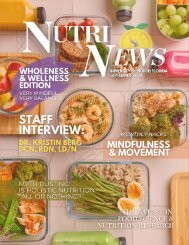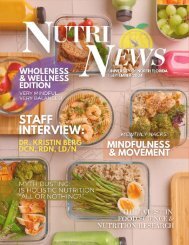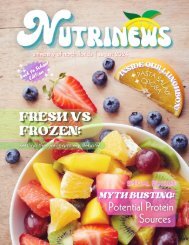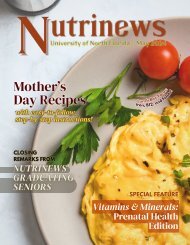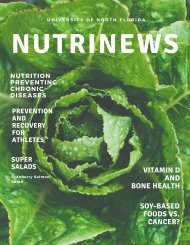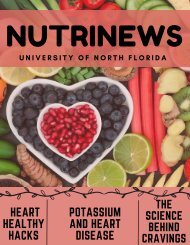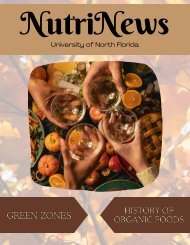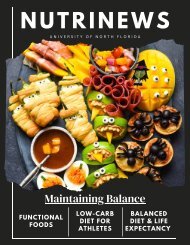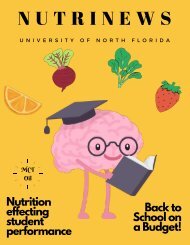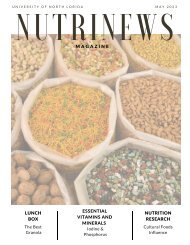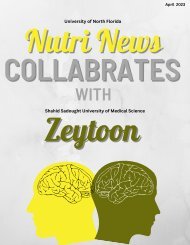MayJune 2022 Magazine (1)
The theme for May/June is Nutrition and Mental Health! Student Spotlight is Laura Rogers. An amazing interview with Dr. Labyak. Lots of incredible articles regarding nutrition and dementia. Enjoy!
The theme for May/June is Nutrition and Mental Health! Student Spotlight is Laura Rogers. An amazing interview with Dr. Labyak. Lots of incredible articles regarding nutrition and dementia.
Enjoy!
You also want an ePaper? Increase the reach of your titles
YUMPU automatically turns print PDFs into web optimized ePapers that Google loves.
Table of Contents<br />
2<br />
COVID CORNER<br />
9<br />
STUDENT SPOTLIGHT<br />
Laura Rogers<br />
5<br />
MYTHBUSTING<br />
Can your diet have an impact<br />
on preventing dementia?<br />
14<br />
NUTRITION<br />
RESEARCH<br />
How Food Impacts Mental Health<br />
7<br />
FOOD SCIENCE<br />
Plants, Herbs and Mental<br />
Health<br />
17<br />
THE LUNCH BOX<br />
Tomato & Mushroom Pesto<br />
Pasta<br />
18<br />
INTERNATIONAL<br />
COLLABORATION<br />
Nutrition in the patients living<br />
with HIV/AIDS: A translational<br />
Approach<br />
25<br />
FACULTY<br />
SPOTLIGHT<br />
An interview with Dr. Corinne<br />
Labyak<br />
21<br />
SHOPPING IN SEASON<br />
Rocket Greens<br />
29<br />
NUTRI NEWS STAFF<br />
GRADUATES<br />
24<br />
MONTHLY HACKS<br />
Can risk for dementia be<br />
decreased?<br />
35<br />
NUTRINEWS<br />
STAFF<br />
Meet our staff!<br />
40<br />
OPPORTUNITIES<br />
WITH NUTRI NEWS<br />
Follow us!<br />
@unfnutrinews<br />
https://unfnutrinews.wordpress.com
confident in their knowledge of COVID-19.<br />
Knowing this, it is very interesting how this<br />
pandemic has quickly shifted our normal<br />
reality, especially because a lot of individuals<br />
said they wished to get back to how it was<br />
before. I do not think that we will ever go back<br />
to what it was like before the pandemic and<br />
we have all changed in response to COVID.<br />
That should not dissuade us from longing for<br />
the end of COVID though, so remember to<br />
wear a mask, wash your hands, and get<br />
vaccinated.<br />
I hope everyone has a safe and COVID-free<br />
summer break!<br />
3
Happy<br />
Mothers<br />
<br />
Day<br />
M A Y 8 T H , 2 0 2 2<br />
4
NUTRITION & DEMENTIA:<br />
CAN YOUR DIET HAVE AN IMPACT ON<br />
PREVENTING DEMENTIA?<br />
BY: DAHININE MOYER<br />
There are over 10 million new cases of dementia<br />
each year worldwide, implying one new case<br />
3<br />
every 3.2 seconds. There are so many things that<br />
people can do to prevent Alzheimer’s/dementia<br />
disease. It starts with nutrition, exercise, stress<br />
management, restorative sleep, and optimizing<br />
cognitive activity. It’s not just doing one of them<br />
at a time, it is doing all of them comprehensively<br />
and in a multifaceted way, all the time, and as<br />
early as possible in life. Genetics plays a role in<br />
Alzheimer’s, but only a small percentage of<br />
people have a strong genetic risk for developing<br />
Alzheimer’s disease. So, it is what you do in your<br />
life and your lifestyle that determines your brain<br />
health.<br />
The Finnish finger study has made some<br />
interesting discoveries. This study shows that<br />
multi-domain lifestyle-based intervention can<br />
prevent cognitive impairment among elderly<br />
persons. This study shows us that we need to<br />
focus on dietary patterns, not just single<br />
nutrients. Several nutrients are important<br />
including B vitamins, vitamin D, and Omega 3<br />
fatty acids. These nutrients come from a variety<br />
of foods and seem to work best when you eat<br />
2<br />
these foods and consume a healthy diet.<br />
5
The MIND diet stands for Mediterranean- DASH Intervention for Neurodegenerative Delay.<br />
1<br />
It has been found to reduce the risk of developing Alzheimer’s disease by 53%. The MIND<br />
diet is designed to prevent Alzheimer’s / dementia as you age. This diet is for all stages and<br />
ages of life. The MIND diet has you eating loads of vegetables such as green leafy ones like<br />
kale, collards, spinach, and lettuce. Greens are packed with folate, vitamin E, carotenoids,<br />
and flavonoids. Aim to eat at least six servings a week of greens. Round out with at least one<br />
serving of other vegetables a day. Make sure to maximize your flavonoids by eating your<br />
berries. Nuts are full of fat-soluble vitamins that have brain-protective qualities. A small<br />
handful a day is all you need. Consuming animal proteins sparingly. Embrace plant proteins<br />
such as beans, lentils, and soybeans. These plant proteins are full of fiber and are rich in B<br />
4<br />
vitamins, which are important to brain health.<br />
Reference List<br />
1.Morris MC. Diet for the mind: The latest science on what to eat to prevent Alzheimer's and cognitive decline -- from the creator of the mind diet /Dr. Martha Clare Morris; with 80<br />
recipes by Laura Morris. First edition ed.; 2017:276-276 pages. https://www.proquest.com/books/diet-mind-latest-science-on-what-eat-prevent/docview/2101321302/se-2?<br />
accountid=14690.<br />
2. Kivipelto M, Solomon A, Ahtiluoto S, et al. The Finnish Geriatric Intervention Study to Prevent Cognitive Impairment and Disability (FINGER): study design and progress. Alzheimers<br />
Dement. 2013;9(6):657-665. https://doi.org/10.1016/j.jalz.2012.09.012<br />
3.Dementia statistics. Alzheimer's Disease International. https://www.alzint.org/about/dementia-facts-figures/dementia-statistics/ Accessed March 29, <strong>2022</strong>.<br />
4. Mayo Clinic staff. Healthy lifestyle: Nutrition and healthy eating. Mayoclinic.org. https://www.mayoclinic.org/healthy-lifestyle/nutrition-and-healthy-eating/in-depth/improve-brainhealth-with-the-mind-diet/art-20454746<br />
Published July 31, 2019. Accessed March 29, <strong>2022</strong>.<br />
6
Plants, Herbs, & Mental<br />
Health<br />
By: Samantha Dill<br />
Major depressive disorder affects over 7.1% of the population of the United States aged<br />
eighteen and older on an annual basis.<br />
3<br />
The psychiatric ailment is also 22-46% more likely to<br />
occur in those with chronic disorders.1 Therefore, it is related to morbidity and mortality.<br />
Traditional treatment of depression consists of pharmacological methods: monoamine<br />
oxidase (MAO) inhibitors, tricyclic antidepressants, and second-generation antidepressants.<br />
Methods of action for the MAO inhibitors for instance include blocking the transport of<br />
serotonin and norepinephrine; this increases neurotransmission and synaptic c levels.<br />
1<br />
However, there can be adverse effects that accompany the benefits. These effects can<br />
include anxiety, tachycardia, and insomnia.<br />
<br />
This is where the appeal of herbal and botanical approaches interposes. In this context,<br />
herbs are known for their phytochemicals, which can decrease the risk of autoimmune and<br />
cardiovascular disorders. The aromatic herbs oregano and thyme have carvacrol<br />
monoterpenic phenol, which regulates, “human ion channels transient receptor potential V3<br />
and A1”, causes a warm sensation, and suppresses inflammation.1 Another more well-known<br />
phenol is curcumin, the yellow-hued constituent of turmeric used historically in Oriental<br />
medicine. In a study on rats, administration of curcumin improved behavioral abnormalities,<br />
decreased immobility time, and increased dopamine in the hippocampus. One of the most<br />
famous (or infamous) herbs is Hypericum perforatum, aka St. John’s Wort. While medical<br />
nutrition therapy students may know it for its drug-nutrient interactions with medications<br />
such as warfarin, St. John’s Wort is generally used for the treatment of depression.<br />
Nonetheless, standardization and quality can be inconsistent.<br />
<br />
All the actions of the herbal medicinal approaches mentioned above attempt to inhibit cell<br />
apoptosis. Providers can recommend these herbal remedies as an alternative to conventional<br />
drugs as a first step, in places they are not accessible, or to those who cannot afford the high<br />
price tags that tend to come with traditional medicine. Regardless of the type of depression<br />
treatment, clinical studies should be conducted to verify the efficacy of the substance.<br />
<br />
SAMHSA’s National Helpline: 1-800-662-HELP<br />
1.<br />
2.<br />
3.<br />
7<br />
References<br />
Lee G, Bae H. Therapeutic Effects of Phytochemicals and Medicinal Herbs on Depression. BioMed Rst. Int. 2017;2017:6596241-11. doi:10.1155/2017/6596241<br />
SAMHSA’s National Helpline. Samhsa.gov. Accessed March 26, <strong>2022</strong>. https://www.samhsa.gov/find-help/national-helpline<br />
Depression statistics. Depression and Bipolar Support Alliance. Published February 8, 2019. Accessed March 26, <strong>2022</strong>.<br />
https://www.dbsalliance.org/education/depression/statistics/
Happy National<br />
Day<br />
T H A N K Y O U F O R C A R I N G<br />
Nurses<br />
M A Y 1 2 T H , 2 0 2 2<br />
8
HOW FOOD IMPACTS<br />
MENTAL HEALTH<br />
By: Haley Brock<br />
Mental health includes our emotional, psychological, and<br />
social well being and it affects not just how we think and feel<br />
but also how we act. In 2020, one in five adults in America<br />
experienced a mental health issue (ranging from anxiety to<br />
depression to bipolar disorder) which makes it clear that<br />
1<br />
mental health is a very important topic. It’s no surprise that<br />
mental health is important (especially at this day and age), but<br />
what might be surprising is how nutrition can have an impact<br />
on mental health.<br />
Diet is what’s known as a “modifiable risk factor” for depression<br />
—meaning that diet choices can raise or lower one’s risk of<br />
suffering from depression. This is not to say that eating a proper<br />
diet can completely prevent depression, but that it can help with<br />
managing the disorder. In one study, participants were<br />
randomly assigned to follow a Mediterranean diet and the<br />
results showed a greater reduction in signs of depression<br />
compared with those who were in a social support group. The<br />
reduction in depressive symptoms had nothing to do with<br />
weight loss or physical activity, it was solely related to the food<br />
2<br />
choices. The Mediterranean diet recommends limiting intakes<br />
of sweets, fried foods, and processed foods and emphasizes<br />
whole grains, vegetables, fruits, legumes, fish, and lean red<br />
meats. One reason this diet may lead to decreased rates of<br />
depression is because it ensures adequate intake of fatty acids,<br />
vitamins, and minerals that are needed for normal physiological<br />
functioning. Lack of intake of certain nutrients, such as zinc,<br />
magnesium, vitamin B12, omega fatty acids, has been linked to<br />
increased risk of depression, thus a whole foods-based diet<br />
usually ensures one is getting an adequate amount of these<br />
nutrients. 2<br />
14
Another way diet can influence depression is through amino<br />
acids and neurotransmitters. Proteins are made up of amino<br />
acids, and many neurotransmitters in the brain are made from<br />
2<br />
amino acids. For example, dopamine, known as the reward<br />
chemical, is made from tyrosine and serotonin, mood<br />
stabilizers, that come from tryptophan. If you don’t consume<br />
enough of these amino acids in your diet, there won’t be<br />
enough to make the neurotransmitters. A lack of these<br />
neurotransmitters has been linked to low moods and<br />
aggression in some patients.<br />
2<br />
Anxiety disorders are actually the most common type of psychiatric<br />
condition in the United States, yet treatment options usually fall short.<br />
3<br />
Luckily, nutrition can be a meaningful way to reduce anxiety. Omega-3 fatty<br />
acids are anti-inflammatory signaling molecules that support the<br />
microbiome and mental health. It is suspected that omega-3’s help to<br />
improve anxiety by regulating the guts microbiome balance, decreasing<br />
inflammation, and balancing neurochemistry by normalizing dopamine<br />
levels. 3 The gut microbiome is an important factor in anxiety and depression<br />
and recently research has demonstrated how the health of our gut can be<br />
related to stress reactivity and stress-related behaviors.<br />
Diet is a modifiable factor that can reduce levels of anxiety, stress, and depression.<br />
Omega-3 fatty acids have been found to help reduce stress and anxiety and can be<br />
found in foods like salmon, avocados, and nuts. Complex carbohydrates can increase<br />
levels of the neurotransmitter serotonin, which has a calming effect. Complex<br />
carbohydrates are found in foods including oatmeal, whole-grain breads, quinoa, and<br />
sweet potatoes. Eating enough protein, specifically proteins containing tryptophan and<br />
tyrosine, can help reduce depression by improving levels of serotonin and dopamine.<br />
Some sources of these amino acids are turkey, chicken, milk, cheese, nuts and seeds, as<br />
well as soy products, avocados, cottage cheese, and beans.<br />
<br />
1.<br />
2.<br />
3.<br />
15<br />
References:<br />
Norwitz NG, Naidoo U. Nutrition as metabolic treatment for anxiety. Frontiers in Psychiatry. Published February 12, 2021. Accessed April 9, <strong>2022</strong>.<br />
https://www.ncbi.nlm.nih.gov/pmc/articles/PMC7907178/<br />
Rao TSS, Asha MR, Ramesh BN, Rao KSJ. Understanding nutrition, depression and mental illnesses. Indian Journal of Psychiatry. Published April 2008.<br />
Accessed April 9, <strong>2022</strong>.<br />
https://www.ncbi.nlm.nih.gov/pmc/articles/PMC2738337/#:~:text=Tryptophan%20in%20the%20brain%20affects,triggered%20by%20carbohydrate%20rich%2<br />
0foods<br />
Nutrition and behavioral health disorders: depression and anxiety. Academic.oup.com. Accessed April 9, <strong>2022</strong>.<br />
https://academic.oup.com/nutritionreviews/article/79/3/247/5843529?login=true
THANK YOU<br />
FOR YOUR<br />
SERVICE<br />
MILITARY APPRECIATION MONTH<br />
MAY <strong>2022</strong><br />
16
TOMATO & MUSHROOM<br />
PESTO PASTA<br />
BY PAIGE COURTIER<br />
Ingredients<br />
2 cups Barilla protein rotini, dry<br />
2-3 tbsp pesto<br />
5 grape tomatoes, sliced in half<br />
2 mushrooms, thinly sliced<br />
1 cup spinach<br />
2 tbsp olive oil<br />
Salt and pepper<br />
1 tbsp parmesan<br />
Instructions<br />
Follow the cooking instructions on<br />
the pasta box.<br />
Heat a nonstick pan.<br />
In the pan, add olive oil and the<br />
sliced mushrooms and tomatoes.<br />
Add salt and pepper to taste.<br />
Sauté mushrooms and tomatoes in<br />
olive oil for 4 minutes.<br />
Add spinach and sauté until wilted.<br />
Strain the pasta and add in the pesto.<br />
Add in the sauteed vegetables and<br />
top with parmesan.<br />
17
N U T R I T I O N I N T H E P A T I E N T S<br />
L I V I N G W I T H H I V / A I D S : A<br />
BY; Salas-García Miguel Amaury, Pérez-Malta Paola Lizbeth,<br />
T R A N S L A T I O N A L A P P R O A C H<br />
and López-Quintero Andrés<br />
<br />
<br />
In collaboration with the University of Guadalajara<br />
Now for those of you interested toThe human<br />
immunodeficiency virus (HIV) and its final stage,<br />
Acquired Immunodeficiency Syndrome (AIDS),<br />
targets the human immune system, increasing<br />
susceptibility to infections and certain types of<br />
cancer1. Although the disease has been<br />
identified since the 1980s, it is still considered a<br />
pandemic that represents a vital public health<br />
problem, particularly in resource-limited<br />
countries such as Mexico. Nowadays there is no<br />
treatment that eliminates the disease,<br />
antiretroviral treatment or ART (a combination<br />
of drugs) is capable of slowing its progression<br />
and limiting the damage it causes; however, 1<br />
out of 4 individuals under ART fails in adhering<br />
to these drugs as a consequence of social,<br />
economic and nutritional reasons. Among the<br />
latter, HIV impact on the patient nutritional<br />
status has been identified even in the early<br />
stages of this epidemic, where weight loss was<br />
considered as one of the most visible signs of<br />
malnutrition in patients progressing to AIDS.<br />
Interestingly, weight loss is associated with loss<br />
of both muscle and fat, and it is often<br />
accompanied to a large extent by vitamin and<br />
mineral deficiencies, as well as alterations<br />
2<br />
4<br />
5<br />
in blood lipid concentrations.<br />
In most cases, multiple causes of<br />
malnutrition have been identified in<br />
patients living with HIV/AIDS. In this way,<br />
primary and secondary malnutrition have<br />
been described, both of which can coexist in<br />
patients. The former is due to inadequate<br />
consumption of food and essential nutrients,<br />
mainly because of lack of access and<br />
availability, while the second is the result of<br />
mechanisms proper to HIV, such as<br />
increased energy expenditure,<br />
malabsorption or impairment in the<br />
utilization of nutrients.<br />
Regardless of the<br />
causes, malnutrition increases vulnerability<br />
to the different post-infection impacts, while<br />
also affecting the evolution and prognosis of<br />
the disease.<br />
Thus, compromised nutritional status<br />
results in accelerated progression of HIV to<br />
AIDS, as well as decreased adherence and<br />
response to ART therapy, and at the same<br />
time, exacerbates the socioeconomic<br />
impact of the disease.<br />
7<br />
4<br />
4,7,8<br />
4,6<br />
18
Patients living with HIV/AIDS constitute a<br />
population with specific nutritional<br />
requirements that would benefit largely from<br />
the improvement of their nutritional status,<br />
therefore it is necessary to direct efforts to<br />
respond to their health needs.<br />
6<br />
Despite the important role of nutrition in<br />
this disease, not enough importance has yet<br />
been given to it and more efforts are required<br />
to provide adequate nutritional assessment<br />
and treatment in patients living with<br />
HIV/AIDS. This justifies a translational<br />
approach, i.e., research that is able to link the<br />
following: basic research (such as molecular<br />
sciences), its application, its adaptation to the<br />
context in which it will be used, and its<br />
maintenance in society.<br />
9,10<br />
In this sense,<br />
translational nutrition consists of 5 phases (T0<br />
to T4) that may be applied at the service of<br />
patients living with HIV/AIDS10. Phase T0<br />
refers to the ability of researchers to identify<br />
the opportunities and needs of the<br />
population. Nutritional status has been<br />
detected as a factor influencing treatment<br />
response, disease progression and quality of<br />
life. On the other hand, phase T1 refers to the<br />
application of knowledge in possible<br />
scenarios. In this regard, it is necessary to<br />
transfer basic knowledge to the clinical<br />
scenario that addresses the nutritional needs<br />
of these patients. Phase T2 involves<br />
generating evidence-based clinical practice<br />
guidelines. This means that the knowledge<br />
19
obtained can be used by health professionals<br />
for the benefit of patients. Phase T3 represents<br />
the transition from the use of knowledge in<br />
small populations to broader groups, such as<br />
communities, and it also includes the<br />
identification of barriers that interfere with its<br />
application. Finally, phase T4 allows knowledge<br />
to be applied at the societal level, for example,<br />
through government information campaigns<br />
and public policies that allow it to reach all<br />
patients, particularly the most vulnerable.<br />
Translational research aims to shorten the<br />
distance between laboratory developments and<br />
clinical benefit to the patient. Thus, the<br />
translational nutrition approach will lead to a<br />
better understanding of the nutritional impact<br />
of HIV, as well as the study of possible foodderived<br />
compounds that may have a positive<br />
11<br />
effect on the disease. This could translate into<br />
specific and precise nutritional strategies for<br />
HIV/AIDS, which in turn could reduce the<br />
burden of the disease for health systems and for<br />
the patients themselves.<br />
9<br />
References:<br />
1. WHO. HIV/AIDS. Published 2021. https://www.who.int/news-room/fact-sheets/detail/hivaids<br />
2. Noris D, Pavía S, Dora D, et al. Características epidemiológicas de pacientes con vih-sida<br />
atendidos en un hospital del sur de la Ciudad de México durante 2011 a 2016. Asoc Mex<br />
Infectología y Microbiol Clínica,AC. 2018;38(3):67-98.<br />
https://www.medigraphic.com/pdfs/micro/ei-<br />
2018/ei183c.pdf%0Ahttps://www.scopus.com/record/display.uri?eid=2-s2.0-<br />
85069446799&origin=resultslist&sort=plff&src=s&nlo=&nlr=&nls=&sid=1413e2b530796303080175745bb67b22&sot=b&sdt=cl&cluster=sco<br />
pubyr%25252C%25252<br />
3. Palios J, Kadoglou NPE, Lampropoulos S. The pathophysiology of HIV-/HAART-related<br />
metabolic syndrome leading to cardiovascular disorders: The emerging role of adipokines.<br />
Exp Diabetes Res. 2012;2012. doi:10.1155/2012/103063<br />
4. Berhe N, Tegabu D, Alemayehu M. Effect of nutritional factors on adherence to<br />
antiretroviral therapy among HIV-infected adults: A case control study in Northern Ethiopia.<br />
BMC Infect Dis. 2013;13(1). doi:10.1186/1471-2334-13-233<br />
5. Myezwa H, Hanass-Hancock J, Pautz N. Investigating the interaction between human<br />
immunodeficiency virus, nutrition, and disability: A cross-sectional observational study.<br />
African J Prim Heal Care Fam Med. 2018;10(1):1-8. doi:10.4102/phcfm.v10i1.1663<br />
6. Weiss JJ, Sanchez L, Hubbard J, Lo J, Grinspoon SK, Fitch K V. Diet Quality Is Low and<br />
Differs by Sex in People with HIV. J Nutr. 2019;149(1):78-87. doi:10.1093/jn/nxy241<br />
7. Nanewortor BM, Saah FI, Appiah PK, Amu H, Kissah-Korsah K. Nutritional status and<br />
associated factors among people living with HIV/AIDS in Ghana: cross-sectional study of<br />
highly active antiretroviral therapy clients. BMC Nutr. 2021;7(1):1-8. doi:10.1186/s40795-021-<br />
00418-2<br />
8. Flores-López G, Flores-Arenales I. Suplementación nutricional, ganancia ponderal en<br />
pacientes con VIH / SIDA. RevSalJal. 2020;(1):58-62.<br />
9. Betancourt Bethencourt JA, Ramis Andalia RM, Mirabal Nápoles M. Investigación<br />
traslacional y transdisciplinaria en salud pública TT - Translational and transdisciplinary<br />
research in Public Health. Rev Cuba Salud Pública. 2014;40(2):239-248.<br />
http://www.scielosp.org/scielo.php?script=sci_arttext&pid=S0864-<br />
34662014000200008&lang=pt%0Ahttp://www.scielosp.org/pdf/rcsp/v40n2/spu08214.pdf<br />
10. Rey R. Medicina Traslacional: una nueva denoMinación para una prácTica ancesTral<br />
investigación Traslacional en Medicina. Rev Hosp Niños (B Aires). 2016;58(262):142-148.<br />
11. Goga A, Doherty T, Manda S, et al. Translating new evidence into clinical practice: A quasiexperimental<br />
controlled before-after study evaluating the effect of a novel outreach<br />
mentoring approach on knowledge, attitudes and confidence of health workers providing<br />
HIV and infant feeding coun. BMJ Open. 2020;10(10):1-13. doi:10.1136/bmjopen-2019-034770<br />
20
Nutritionally, arugula contains vitamin<br />
2,3<br />
A, folate, vitamin K and Vitamin C. Since<br />
the nutritional profile is not as extensive<br />
as other types of greens, it is important to<br />
mix arugula with other nutrient packed<br />
foods. There are some safety risks when it<br />
comes to purchasing these greens<br />
because most of America’s supply of<br />
arugula is grown in states like California<br />
and Arizona, where the chemical input is<br />
larger than other states. Therefore, it is<br />
important to wash them properly before<br />
4<br />
eating to get rid of any contaminants.<br />
SHOPPING IN<br />
SEASON<br />
Rocket Greens<br />
By Alicia Scott<br />
The famous “rocket greens” are more<br />
commonly known as arugula. These<br />
types of greens are mostly seen in salads<br />
alongside other fresh vegetables. Arugula<br />
is popular in the Mediterranean region<br />
and southern Europe.1 Rocket greens<br />
have become more popular here in the<br />
states over the years. They are relatives of<br />
watercress and radish greens and have a<br />
2<br />
spicy flavor to them. Rocket greens are<br />
fast growing and are usually grown in the<br />
cooler weather of fall or spring.<br />
Like most greens, one of the main things<br />
that impact their longevity is storage. It is<br />
important to store arugula in the same<br />
container that it was bought in to keep it<br />
as fresh as possible. Arugula should be<br />
used soon after purchasing because it<br />
does not keep well, even in the<br />
refrigerator. If possible, buy from local<br />
markets before purchasing from larger<br />
chain stores to support your community’s<br />
local businesses.<br />
Rockets greens are mostly seen in salad<br />
recipes but there are several diverse ways<br />
they can be used outside of salads. One<br />
interesting way is using these greens to<br />
make a pesto. Enjoy this recipe for May’s<br />
in-season vegetable which highlights<br />
arugula in a fresh pesto.<br />
21
GRILLED CHICKEN WITH ARUGULA PESTO<br />
COURTESY OF RACHEL RAY<br />
Ingredients<br />
¼ cup sliced or slivered almonds or<br />
shelled pistachios<br />
1 cup packed fresh arugula leaves<br />
½ cup packed fresh basil leaves<br />
½ lemon, juiced<br />
1 clove garlic, grated or minced<br />
Salt and freshly ground black pepper<br />
1/3 cup extra-virgin olive oil<br />
4 small pieces boneless, skinless<br />
chicken breast (tenders removed)<br />
Directions<br />
1. Heat a grill pan to high.<br />
2. Lightly toast nuts in small skillet over low heat,<br />
then chop using a food processor or blender.<br />
3. Add the arugula, basil, lemon juice, garlic, salt<br />
and pepper to the food processor with the almonds<br />
and mix.<br />
4. While the processor is on, slowly pour in the oil<br />
to form a thick pesto.<br />
5. Lightly pound out the chicken, then baste with<br />
pesto. Brush grill pan with olive oil and grill the<br />
chicken for 2 to 4 minutes on each side.<br />
CAN BE SERVED OVER SPAGHETTI, RICE OR EVEN USED TO MAKE A SANDWICH.<br />
REFERENCES<br />
1. ARUGULA. WISCONSIN DEPARTMENT OF PUBLIC INSTRUCTION WEBSITE. HTTPS://DPI.WI.GOV/SITES/DEFAULT/FILES/IMCE/SCHOOL-NUTRITION/PDF/FACT-SHEET-ARUGULA.PDF. ACCESSED MARCH 31, <strong>2022</strong>.<br />
2. CHRISTENSEN T. WHAT ARE ROCKET GREENS? DELIGHTED COOKING WEBSITE. HTTPS://WWW.DELIGHTEDCOOKING.COM/WHAT-ARE-ROCKET-GREENS.HTM. PUBLISHED MARCH 31, <strong>2022</strong>. ACCESSED MARCH 31, <strong>2022</strong>.<br />
3. FOODDATA CENTRAL SEARCH RESULTS. FOODDATA CENTRAL WEBSITE. HTTPS://FDC.NAL.USDA.GOV/FDC-APP.HTML#/FOOD-DETAILS/169387/NUTRIENTS. ACCESSED MARCH 31, <strong>2022</strong>.<br />
4. ARUGULA. FOODPRINT WEBSITE. HTTPS://FOODPRINT.ORG/REAL-FOOD/ARUGULA/. PUBLISHED FEBRUARY 18, 2020. ACCESSED MARCH 31, <strong>2022</strong>.<br />
5. RAY R. GRILLED CHICKEN WITH ARUGULA PESTO. FOOD NETWORK WEBSITE. HTTPS://WWW.FOODNETWORK.COM/RECIPES/RACHAEL-RAY/GRILLED-CHICKEN-WITH-ARUGULA-PESTO-RECIPE-1952409. PUBLISHED JUNE 12, 2014. ACCESSED MARCH 30, <strong>2022</strong>.<br />
22
M E N T A L H E A L T H<br />
Awareness<br />
Month<br />
1 in 5 AMERICANS EXPERIENCE A MENTAL<br />
ILLNESS IN A GIVEN YEAR<br />
23<br />
For more information visit<br />
https://www.cdc.gov/mentalhealth/learn/index.htm
Can Risk for Dementia Be Decreased?<br />
by: Melissa Brennan<br />
Dementia is not a single disease state, but instead is an umbrella term that covers many conditions involving<br />
1<br />
loss of memory and other thinking abilities that are progressive enough to interfere with daily life. Some of<br />
the most common dementias include Alzheimer’s, Lewy body dementia, vascular dementia, fronto temporal<br />
dementia, Parkinson’s disease, Huntington’s disease, and mixed dementias that come from more than one<br />
cause. While the signs and symptoms of dementia can vary between individuals, some common examples are<br />
difficulty with short term memory, not being able to keep track of purse, wallet, bills, or regular<br />
appointments, difficulty planning and preparing meals, traveling to areas outside of neighborhood and<br />
getting lost, and confusion. The various kinds of dementia and their signs and symptoms correspond with<br />
certain types of brain cell damage in particular areas of the brain. For example, in individuals with<br />
Alzheimer’s disease, proteins surround brain cells and make it hard for them to communicate with each other<br />
and stay optimally functioning. The first region typically damaged in Alzheimer’s disease is the hippocampus,<br />
which is the area responsible for memory and is the center for learning; therefore, memory loss is typically<br />
one of the earliest symptoms of Alzheimer’s disease.<br />
While some risk factors for dementia are difficult or impossible to change, such as age, genetics, and<br />
education level, there are a few modifiable risk factors that could help prevent future cognitive decline or<br />
2<br />
even reverse some of the symptoms. Most changes in the brain that cause dementia are permanent and<br />
irreversible, however some thinking and memory problems caused by depression, medication side effects,<br />
excess alcohol consumption, thyroid problems, and vitamin deficiencies can all be addressed to improve an<br />
1<br />
individual’s condition. Before the onset of dementia, there are a few things that can be done to help protect<br />
the brain and reduce risk:<br />
· Treat depression and loneliness/social isolation<br />
· Be as active as you can by exercising regularly and practicing joyful/intuitive movement<br />
· Smoking cessation<br />
· Keep alcohol consumption within recommended limits<br />
· Try to consume a balanced diet<br />
· Maintain blood pressure within a normal rang<br />
While modifying these risk factors is easier said than done, the best thing you can do for your future brain<br />
health is move your body in a way that you enjoy, practice stress reduction techniques, and consume a diet<br />
that is accessible and practical for your lifestyle while implementing gentle nutrition. While genetics and age<br />
cannot be changed to alter the risk for dementia, focusing on reducing risk factors can help you keep a<br />
healthy and active brain.<br />
References:<br />
1. Can Dementia Be Prevented? National Health Service website. https://www.nhs.uk/conditions/dementia/dementia-prevention/. Published June 26, 2020.<br />
Accessed April 7, <strong>2022</strong>.<br />
2. What is Dementia? Alzheimer’s Association website. https://www.alz.org/alzheimers-dementia/what-is-dementia. Accessed April 7, <strong>2022</strong>.<br />
24
FACULTY<br />
SPOTLIGHT<br />
An interview with Dr. Labyak<br />
By Anna Waterman<br />
Background:<br />
Dr. Labyak graduated from Florida State University with a<br />
bachelor’s degree in nutrition and dietetics. She continued<br />
her education here at UNF in the master’s degree and<br />
Dietetic Internship combined program, similar to what the<br />
MSDI is today. Upon graduating from this program, Dr.<br />
Labyak began working as an adjunct professor at UNF<br />
while she pursued her doctorate degree from the<br />
University of Florida. Once she received her doctoral<br />
degree, she began working at UNF as a full-time professor.<br />
Dr. Labyak has taught everything from basic nutrition to<br />
community nutrition to advanced nutrition science.<br />
Additionally, she teaches at all levels including<br />
undergraduate, masters, and doctoral courses.<br />
DR. LABYAK<br />
Furthermore, Dr. Labyak has taken many students under<br />
her wing as a mentor as she guides them through the<br />
various processes of research. She believes mentorship is<br />
vital to student success and giving students opportunities<br />
to participate in research gives them the chance to apply<br />
what they have learned in the classroom.<br />
Continue reading to learn more about Dr. Labyak and how<br />
her research is changing lives.<br />
25
What research are you currently working on and why is it important to you?<br />
To give you some background, Alzheimer’s disease was never on my family’s radar; I<br />
had only read about it in a textbook when I was an undergraduate student.<br />
Then my mom was diagnosed a few years ago and I dove into the research trying to<br />
find anything to help, and there was not much so I became determined to find a cure. I<br />
was focused on stopping the progression of the disease in my mom. And while that<br />
unfortunately did not happen, it led me to my passion of studying Alzheimer’s disease<br />
and finding ways to minimize the risk of developing the disease as well as to help the<br />
caregivers who are caring for loved ones with dementia.<br />
Taking care of the caregivers is an important side of my work because I saw the impact<br />
my mother’s diagnosis had on my dad. “It is unbelievably difficult to watch someone<br />
you love go down this path and you can’t stop it.”<br />
Outside of your research, how are involved with improving the health outcomes for<br />
those with dementia and Alzheimer’s disease?<br />
I’m on the State Health Improvement Plan for Alzheimer’s disease. We have goals for<br />
the state and work toward those goals as a team. I was also recently appointed to the<br />
Alzheimer’s Disease Advisory Committee (ADAC) for the state which meant so much to<br />
me. I found out a year to the day that I lost my mom that I was selected for that<br />
committee. As a part of this committee, I give suggestions to the Department of Elder<br />
Affairs for the state like making recommendations for Alzheimer’s disease and for<br />
caregivers of a loved one with Alzheimer’s disease.<br />
I’m also very involved in the Alzheimer’s walk and was one of their top fundraisers in my<br />
first two years. So, I am very involved in the community aspect of this disease and my<br />
hope is that I can one day contribute to the slowing of the progression of Alzheimer’s<br />
disease.<br />
What is the focus and aim of your current research related to Alzheimer’s and<br />
Dementia?<br />
Overall, I’m hopeful that we can find preventative measures that people can<br />
implement to minimize their risk of developing it because Alzheimer’s starts 10-15 years<br />
prior to someone even showing symptoms. I wish I would have known this when my<br />
mom started showing symptoms so I could have taken her to get screened<br />
immediately. But we just thought it was part of getting older.<br />
The earlier you can find a diagnosis, the more of a chance that people can change<br />
their diet, increase physical activity, and things like that.<br />
26
Are there any current nutrition recommendations that have been proven to either<br />
prevent the development or slow the progression of Dementia?<br />
There is a dietary pattern that is showing some promise. It is called the MIND diet, which<br />
stands for Mediterranean-DASH Diet Intervention for Neurodegenerative Delay. In this<br />
diet, there are 10 food groupings that should be increased in the diet and 5 groupings<br />
that should be minimized. Some of the food groups that should be increased are green<br />
leafy vegetables, berries, whole grains, and fish (not fried) while some of the food<br />
groups that should be minimized are saturated fats, fried foods, and red meat.<br />
Are there ways to test for Dementia before a person shows symptoms?<br />
Thankfully there's been a lot more money put into research for Alzheimer’s disease,<br />
because there is no cure and millions of Americans are being diagnosed every day. I<br />
recently asked a neurologist about more testing and was told that there is talk of<br />
research on blood tests, but nothing has been confirmed. However, there are pet scans<br />
and tests that use cerebrospinal fluid (CSF) to identify AD however the scans are<br />
expensive and the CSF tests are invasive and they can look at other markers for the<br />
disease this way. Additionally, there are many neuropsychological tests that can be<br />
performed as a part of the diagnosis.<br />
The most important thing is if you suspect that your loved one is showing signs of<br />
dementia, get them to a doctor immediately for testing and be an advocate for them.<br />
What are the research projects that you are currently working on related to<br />
Dementia and Alzheimer’s?<br />
The first one I am working on involves multiple moving parts, one portion is conducting<br />
focus groups consisting of caregivers to loved ones with dementia and healthcare<br />
professionals that specialize in dementia care. The other portion of this study includes<br />
analysis of food frequencies of both the dementia patient and the family caregivers<br />
because malnutrition is common in both populations. We wanted to find the nutritional<br />
concerns of the caregiver because I saw first-hand how taking on this role takes a toll<br />
on family caregivers. Dietary intake of the dementia patient and the caregivers was<br />
compared to the MIND diet and many deficiencies were noted.<br />
Additionally, we are using the information gathered from the focus groups to develop a<br />
program for caregivers to increase the intake of their loved one with dementia as well<br />
as themselves.<br />
For the second project, I am teaming up with Dr. Arikawa and the director of the Center<br />
for Aging here at UNF, Dr. Cynthia Williams. We will be analyzing multiple aspects of diet<br />
and the microbiome in relation to dementia. This project isn’t even off the ground, so<br />
there are some very exciting things on the horizon!<br />
27
Do you have any advice for students pursuing a degree in nutrition and dietetics?<br />
I always encourage students to take advantage of research opportunities and getting<br />
different experiences. Like working as a diet tech at a local hospital, for example,<br />
because getting hands-on experience is so important to be able to apply what you are<br />
learning in the classroom.<br />
Also, find what you are passionate about within this field. When you find your passion,<br />
the work doesn’t feel like work and is so much more rewarding. The past few years have<br />
really done that for me, and it has been incredible to see how doors have opened when<br />
I started pursuing something that was very close to my heart.<br />
*If you or someone you know is interested in participating in research regrading<br />
dementia and Alzheimer’s, please reach out to Dr. Labyak at c.labyak@unf.edu.<br />
28
29<br />
G<br />
R<br />
A<br />
D<br />
U<br />
A<br />
T<br />
E<br />
S
Laura Rogers, B.S. in Nutrition and<br />
Dietetics<br />
After graduation, I will have a month off<br />
before I begin the online Master’s in<br />
Nutrition and Dietetics via UNF this<br />
summer. Then, in the fall, I will start my<br />
dietetic internship with the Florida<br />
Department of Health, with who I will be<br />
working after the internship is over. With a<br />
passion for community nutrition, I am<br />
beyond excited to dive head-first into this<br />
program. It is wild to think that this time<br />
next year, I will be studying to sit for the RD<br />
exam!<br />
Alexandra Threlkeld, B.S. in Nutrition and<br />
Dietetics<br />
After graduation, I will be moving to<br />
Tallahassee, FL and pursuing an MS<br />
degree in Exercise Physiology with a<br />
concentration in Sports Nutrition. I will then<br />
apply to FSU’s Dietetic Internship and<br />
hopefully become one of their interns! I<br />
hope to be a sports performance dietitian<br />
for a professional sports team in the future!<br />
Go Ospreys and Go Noles!<br />
30
Janine DAmico, B.S. in Nutrition and<br />
Dietetics<br />
I have been accepted into the Florida<br />
Department of Health Pasco County<br />
Dietetic Internship. This is a nine-month<br />
program that I hope will allow me to get a<br />
better idea of where I want to focus as an<br />
RD, although I know I want to do<br />
something in community or public health.<br />
I am also pursuing my master's degree<br />
online at UNF, so although I am<br />
graduating, classes start again soon and I<br />
will be here for another year!<br />
Samantha Dill, B.S. in Nutrition and<br />
Dietetics<br />
Upon graduation, I will interning with<br />
Advent Health while getting my Masters<br />
in Nutrition and Dietetics at UNF.<br />
31
Rayonna Hills, B.S. in Nutrition and<br />
Dietetics<br />
I will be furthering my education at the<br />
University of North Florida as a graduate<br />
student pursuing a Masters in Nutrition and<br />
Dietetics and being a dietetic intern. I aspire<br />
to become a registered dietitian working in<br />
a clinical setting but I do have particular<br />
interests in diabetes and education.<br />
<br />
<br />
<br />
Brianna Brand, B.S. in Nutrition and<br />
Dietetics<br />
I got matched to the Komplete Business<br />
Dietetic Internship and start my rotations<br />
in September. Because KBDI is a<br />
distance internship, I am able to stay in<br />
Jacksonville and fulfill my rotations with<br />
preceptors I picked out in the area. I am<br />
interested in corporate wellness and<br />
opening my own business centered<br />
around personal training and nutrition<br />
counseling.<br />
32
Atalia Vazquez, B.S. in Nutrition and<br />
Dietetics<br />
I was fortunate to match to OSF Saint<br />
Francis Medical Center in Peoria, IL. I will<br />
be moving to Illinois shortly after<br />
graduation towards the end of May since<br />
my internship starts in June. It's a 52-<br />
week program that is not combined with a<br />
master's, but I believe this time will allow<br />
me to find my niche in dietetics and<br />
decide what graduate program I want to<br />
pursue. I'm excited to embark on this new<br />
academic voyage, and I'm forever blessed<br />
to have worked with such a remarkable<br />
group of people at NutriNews.<br />
33<br />
Anna Waterman, B.S. in Nutrition and<br />
Dietetics<br />
I am continuing my education at UNF as<br />
a biology major to complete prerequisite<br />
courses before applying to<br />
Physician Assistant programs. I will<br />
work as a research assistant while I<br />
work toward this next step in my<br />
education. Being a part of the nutrition<br />
and dietetics program at UNF has been<br />
incredible. If you are at all interested in<br />
pursuing nutrition as a career path, I<br />
highly recommend this program!!
Haley Brock, B.S. in Nutrition and<br />
Dietetics<br />
After graduation, I will be moving to<br />
Tampa and starting my Master’s Degree<br />
in Public Health at USF before I start my<br />
internship with the Bay Pines VA<br />
Hospital! I’m so excited for this<br />
opportunity and I’m looking forward to<br />
seeing this side of the field of dietetics.<br />
After my internship, I plan to focus on<br />
intuitive eating and eating disorder<br />
recovery.<br />
Dalila Mumic, B.S. in Nutirtion and<br />
Dietetics<br />
After graduation, I’ll be completing the<br />
registration exam this summer to become a<br />
Nutrition and Dietetic Technician and work<br />
in clinical nutrition alongside RDs. My next<br />
plan will be to complete a masters program<br />
in psychology and counseling. And my<br />
overall goal is to get into a dietetic<br />
internship and become an RD.<br />
34
Meet The Staff<br />
Anna Waterman<br />
Editor in Chief<br />
Laura Rogers<br />
Co-Editor in Chief<br />
Anna McQueen<br />
Head Publisher<br />
35
Meet The Staff<br />
Melissa Brennan, M.S.<br />
Head Writer<br />
Maritza Ou<br />
Website Manager<br />
Lindsey Cedeno-Ortiz<br />
Media Manager<br />
Priscilla Stevens<br />
Flyer Creator<br />
36
Meet The Staff<br />
Alexandra Threlkeld<br />
Secretary<br />
Atalia Vazquez<br />
Treasurer<br />
Dr. Alireza Jahan-Mihan<br />
Faculty Advisor<br />
37
Meet The Staff:<br />
Larissa DePasqua<br />
Editor<br />
Dalila Mumic<br />
Editor<br />
Janine DAmico<br />
Editor<br />
38
Meet The Staff<br />
Tiffany Hunnicutt<br />
Publisher<br />
Saily Medero<br />
Publisher<br />
Rayonna Hills<br />
Publisher<br />
39
40
NutriNews Snack Sponsors!<br />
Thank<br />
you!




